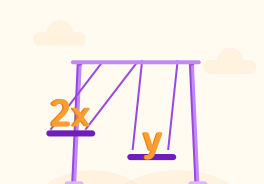YOU ARE LEARNING:
Simultaneous Equations: Elimination 2

Simultaneous Equations: Elimination 2
Building on the first elimination lesson, learn how to solve simultaneous equations when their coefficients are different.
Elimination is a method of solving simultaneous equations. Sometimes, you will have to multiply one or both equations before they can be added together to eliminate one of the variables.
Have a look at −3x+2y=5 and 6x+5y=8
Neither the x or y coefficients here add to make 0. We need to multiply the equations first to be able to eliminate one of the variables.
Let's have a go at solving −3x+2y=5 and 6x+5y=8 simultaneously
Label the equations 1 and 2
(1)−3x+2y=5 and (2) 6x+5y=8
Multiply the equations to make a variable add to 0
The goal is to multiply one or both of the equations so that when we add them together, either x or y adds together to give 0, and therefore allows us to find the other.
Multiply equation (1) by 2 to equalise x
2×(−3x+2y=5) becomes −6x+4y=10
Add −6x+4y=10 and 6x+5y=8
4y+5y=10+8
9y=18
9y=18, so what is y?

Put y=2 into equation 1
−3x+2(2)=5
Solve −3x+2(2)=5 to find x as a fraction

Nice! You've solved it
x=−31 and y=2
Solve 2x+y=5 and 3x−2y=4

Try solving 3x+y=10 and 2x−3y=14

Sometimes you will be given two equations where both may have to be multiplied by different numbers before a variable can be eliminated.
Look at 3x+2y=4 and 2x+3y=6. In order to solve, we need to eliminate y
Label equations 1 and 2
(1) 3x+2y=4 and (2) 2x+3y=6
Multiply equation (1) by 3
3×(3x+2y=4)→9x+6y=12
Multiply equation (2) by -2
−2×(2x+3y=6)→−4x−6y=−12
Add the equations together
(9x+6y=12)+(−4x−6y=−12)→5x=0
5x=0, so what is x?

Put x=0into equation (1)
3(0)+2y=4
3(0)+2y=4, so what is y?

y=2
Nice! We have solved the simultaneous equations. x=0 and y=2.
Have a go at solving these: 4x+3y=17 and 3x−4y=−6

Now try 3x+2y=17 and 2x+5y=26

